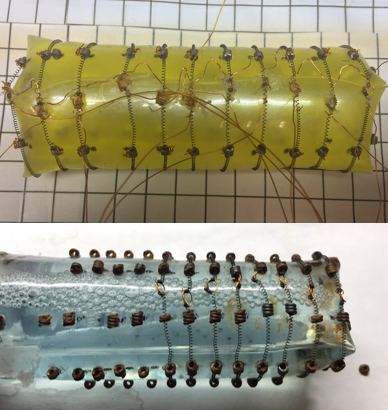 |
Design Process
Our design uses thermally activated SMA contractile rings to invert an FFT. By contracting the rings on either end, we are able to achieve WSL through inversion of the torus.
The prototype was designed in three steps. First, we identified an appropriate toroidal membrane to support the drive system. Then, we designed brackets compatible with the membrane and quantitatively measured the required force necessary to invert the torus. Next, we designed SMA coil actuators to meet these specifications and assembled the completed prototype.
Strengths
SMA actuators must cool to a baseline temperature prior to activation. Therefore, cycle time is dependent upon the actuator cooling rate. Our system reduces cycle time through environmental manipulation. Following activation, the contractile rings move to the center of the FFT where they are surrounded by a water filled membrane effectively acting as a heatsink. Additionally, each ring is activated exactly once per toroidal revolution. The combination of a passive heat sink along with infrequent activations of individual contractile rings theoretically gives WSL systems a high speed cap.
Weaknesses
By nature, SMA actuators require significant power. They are heat driven and actuated by running electric current through the actuator wire. This process is approximately 3-5% efficient at converting electrical energy to work (for comparison DC motors can be up to 90% efficient). The final prototype required 3.7 watts of power.
The chosen membrane was not completely compatible with the drive system. The contractile rings occasionally melted through the membrane; the resulting leak was irreparable, requiring fabrication of a new device. As a precaution, our team only heated actuators for fractions of a second, minimizing the potential for damage.
